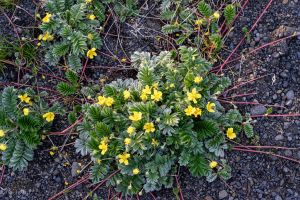 The other leaves in yesterday’s photo of great yellow woodsorrel belong to another five-petalled, yellow-flowering species, Potentilla canadensis (dwarf cinquefoil). This is a low-growing vine in the Rosaceae. It favors drier, rocky soils, like wild pinks and bluets do, and can be found growing near them in the Carderock area.
The other leaves in yesterday’s photo of great yellow woodsorrel belong to another five-petalled, yellow-flowering species, Potentilla canadensis (dwarf cinquefoil). This is a low-growing vine in the Rosaceae. It favors drier, rocky soils, like wild pinks and bluets do, and can be found growing near them in the Carderock area.
This is a good example of a rosaceous flower. The five distinct petals with the sepals peeping out between them are typical of the rose family. The leaf is atypical, being palmately compound with five lobes, but somehow it still looks characteristically rose-like to me, maybe because of the toothed margins.
Dwarf cinquefoil is found in much of the eastern US, especially from South Carolina to New Hampshire and the eastern parts of Ohio, Kentucky, and Tennessee.
 Much more common and widespread is a near look-alike, Potentilla simplex, common cinquefoil. Note that the flowers are almost identical, and the leaves are very similar. To distinguish between the two species, consider these characteristics:
Much more common and widespread is a near look-alike, Potentilla simplex, common cinquefoil. Note that the flowers are almost identical, and the leaves are very similar. To distinguish between the two species, consider these characteristics:
| P. canadensis | P. simplex | |
| vines | generally short, hugging the ground | generally long and sprawling |
| leaflets | toothed more or less halfway along the margins | toothed most of the way along the margins |
| middle leaflet | much wider at the end (obovate) | a little wider at the end (narrowly oval) |
| flowers | generally start at the first node on the vine | generally start at the second node on the vine |
 Another look-alike is in the same family but a different genus… for now. Recent research suggests that Duchesnea indica, false or mock strawberry, should be considered a Potentilla*. A very common lawn and garden weed, and a weed of natural areas as well, it produces fruit that isn’t edible. Well, technically it is edible- it’s not poisonous – but the strawberry-like fruits are flavorless.
Another look-alike is in the same family but a different genus… for now. Recent research suggests that Duchesnea indica, false or mock strawberry, should be considered a Potentilla*. A very common lawn and garden weed, and a weed of natural areas as well, it produces fruit that isn’t edible. Well, technically it is edible- it’s not poisonous – but the strawberry-like fruits are flavorless.
These pictures show an obvious difference between the Potentillas and Duchesnea: the former have five leaflets (hence the common name cinquefoil), while the latter have three leaflets.
*Flora of the Southern and Mid-Atlantic States, Alan S. Weakley; p. 585







